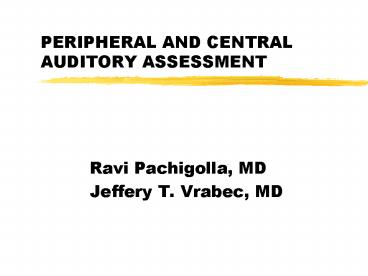PERIPHERAL AND CENTRAL AUDITORY ASSESSMENT - PowerPoint PPT Presentation
1 / 30
Title:
PERIPHERAL AND CENTRAL AUDITORY ASSESSMENT
Description:
... with left sided hearing loss noticed when listening to portable radio. No other otologic complaints, no pmh or contributory family or social history. PE normal ... – PowerPoint PPT presentation
Number of Views:120
Avg rating:3.0/5.0
Title: PERIPHERAL AND CENTRAL AUDITORY ASSESSMENT
1
PERIPHERAL AND CENTRAL AUDITORY ASSESSMENT
- Ravi Pachigolla, MD
- Jeffery T. Vrabec, MD
2
Introduction
- Pure tone audiometry
- Tympanometry
- Acoustic reflex measurements
- ECochG
- Auditory Brainstem Response (ABR)
- Otoacoustic Emissions
3
Pure Tone Audiometry
- Most common test
- Threshold of audibility
- Activation of auditory system
- Energy formatted into neural code
- Air conduction assesses entire system
- Bone conduction assesses cochlea onwards
4
Pure Tones
- Auditory acuity
- Spectrally specific
- High frequency tones stimulate basal turn of the
cochlea - Low frequency tones stimulate apical turn of the
cochlea
5
Decibel Scales
- Sound Pressure Level (SPL)
- Hearing Level (HL)
- Sensation Level (SL)
6
Assessment of thresholds
- Octave frequencies tested
- Bone conduction thresholds
- Mastoid or forehead used
- Mastoid preferred because less intensity required
- Occlusion effect
- Ascending series of tone presentations
7
Speech Audiometry
- Speech Reception Threshold using spondaic words
- Standardized word lists
- Familiarization with spondees
- Ascending series of presentation
- Excellent speech discrimination in conductive
hearing loss patients - Poor speech discrimination in cochlear hearing
loss patients - Poorest speech discrimination in retrocochlear
hearing loss patients
8
Clinical Masking
- Nontest ear can influence thresholds of test ear
- Shadow curve apparent without masking
- Interaural attenuation varies from 40 to 80 dB
with air conduction - Interaural attenuation is about 0 dB with bone
conduction
9
Shadow Curve
10
Clinical Masking cont.
- Compare bone conduction threshold of nontest ear
with air conduction threshold of test ear to
determine whether masking is necessary
11
Masking using narrow bands of noise
12
Plateau method
- Mask nontest ear with progressively greater
amounts of sound until threshold does not rise. - Masking Dilemma
13
Acoustic Immitance
- Impedance
- Reflected energy
- Tympanometry
- Acoustic Reflex
14
Tympanometry configurations
15
Acoustic Reflex Threshold
- Stapedial muscle contraction
- Temporary increase in middle impedance
- Bilateral Stimulation
- Adaptation
- Neural network in lower brainstem
16
Clinical application of ASR
- Middle Ear Disease
- Otosclerosis
- Cochlear hearing loss and loudness recruitment
- Retrocochlear lesions may abolish the ASR
- Brainstem lesions may abolish the contralateral
reflexes - Determination of site of a seventh nerve lesion
- Acoustic Reflex Decay
17
Electrocochleography
- Cochlear Microphonic
- Summating Potential
- Compound Action Potential
- Increased SP/AP ratio suggests hydrops
- Ability to enhance wave I of the ABR in patients
with severe high frequency hearing loss
18
Electrocochleography setup
19
ECochG and Menieres
- Increased SP/AP ratio
- Latency not important
- Ratio greater than 0.45 suggests menieres
- Hydrops affects elasticity of the basilar membrane
20
Auditory Brainstem Response
- Auditory evoked potential
- Farfield recording
- Acoustic clicks or tonal stimuli used
- Rate of stimulus presentation
21
ABR continued
- Waves I - V
- Unaffected by sleep and pharmacotherapy
- ABR latencies decrease from birth until 2 years
- Wave V used for threshold testing (most robust)
- ABR thresholds about 10 to 20 dB poorer than
behavioral measures
22
Latency of response
23
ABR continued
- Lesions of the eighth cranial nerve
- Interwave latency
- Interaural latency difference
- Absolute latency
- Amplitude ratio
24
Retrocochlear lesion
25
Otoacoustic Emissions
- Energy leakage
- Evidence of a healthy, functioning cochlea
- Spontaneous and evoked emissions
- Evoked emission seen only in cochleae with
thresholds less than 20 to 30 dB - Conductive losses affect emissions
- Screening tool in infants
26
Central Auditory Function
- Comprehension
- Background noise
- Behavioral tests
- Monotic vs. dichotic
- Monaural vs. binaural
27
Case Presentation
- 31 yo male with left sided hearing loss noticed
when listening to portable radio - No other otologic complaints, no pmh or
contributory family or social history - PE normal
28
Audiogram
29
Assessment
- Mild high frequency sensorineural hearing loss
- Small amount of rollover
- Ipsi reflexes elevated in left ear
- Contra reflexes elevated in left ear suggesting
retrocochlear pathology - MRI showed 5 mm acoustic neuroma
30
Analysis
- Abnormal reflex responses in left ear indicate
7th nerve affected - Elevated contralateral thresholds in right ear
means that decussating pathways from left VCN to
right brainstem affected































